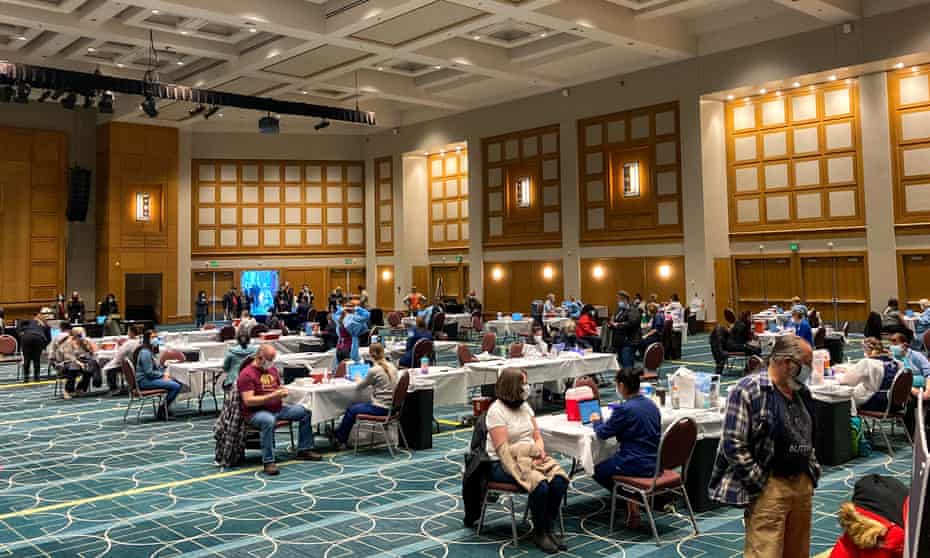Advertisement
begin quote from:
US Covid infections rising again as upper midwest sees biggest jump
Increase comes ahead of Thanksgiving as families gather in homes, and as winter approaches, forcing people indoors

America’s Covid-19 infections are climbing again, and could soon hit a weekly average of 100,000 cases a day as daily case reports increase more than 20% across the upper midwest.
The fresh worsening of the coronavirus pandemic in the US comes as temperatures cool during the approach of winter, forcing people indoors where the virus is believed to spread more readily and may presage another wave.
It is also happening ahead of the Thanksgiving national holiday where tens of millions of Americans are expected to travel all over the country as families gather together in homes for the annual feast.
With medical authorities struggling to get adult vaccination rates above 60% nationally, the states first to experience the onset of winter – Michigan and Minnesota – lead the country “by a significant margin in recent cases per capita”, according to analysis by the New York Times.
The seven-day moving average for the US was 93,196 on Friday. On 25 October it had been 70,271.
However, as federal medical workers travel to Minnesota to support hospital response to the increase in cases, the country as a whole is still averaging far fewer cases a day than it did during the worst of the summer’s Delta variant surge. People who are fully vaccinated are also far less likely to be hospitalized – and very unlikely to die – even if they are infected with the virus.
But several states with high rates of early vaccination take-up, including New Mexico, New Hampshire and Vermont, are also reporting elevated Covid case levels, suggesting that the efficacy of vaccines may be diminishing in terms of infection.
After federal health authorities approved booster shots and vaccines for five- to 12 year-olds, the US is administering about 1.5m new doses a day, with a gently rising graph of vaccination rates still around 15 percentage points below the 80% threshold that epidemiologists would like to see.
On Friday, the FDA approved booster shots to all adults. The Centers for Disease Control and Prevention (CDC) agreed to the new policy.
Under the new rules, anyone 18 or older can choose either a Pfizer or Moderna booster six months after their last dose. For anyone who got the single-dose Johnson & Johnson vaccine, the wait already was just two months. “We heard loud and clear that people needed something simpler and this, I think, is simple,” FDA vaccine chief Dr Peter Marks told the Associated Press.
Around a dozen states had already made boosters available to all adults. “The direction is not a good one. People are going inside more and, ‘oops’, next week happens to be the largest travel week of the year, so it probably makes sense to do whatever we can here to try to turn the tide,” Marks added.
Some experts worry that placing attention on boosters may harm efforts to reach the 47m US adults who remain unvaccinated and widen disparities between wealthy nations and poorer countries who have not been able to acquire sufficient vaccines to treat more than a fraction of their populations.
The rise in new US infections come as several European countries are reporting a brutal resurgence of the coronavirus pandemic. New infections are at record levels in some countries and Austria will reimpose a nationwide lockdown next week, while Germany is clamping down on unvaccinated people and has not ruled out imposing new restrictions on movement.
The European trend toward tighter controls, from mask mandates in Spain to a partial lockdown in the Netherlands, has also led to some outbreaks of unrest.
Violent demonstrations broke out in Rotterdam on Friday night over the Netherlands’ proposals to exclude negative tests from the national health pass, with police firing warning shots and breaking up crowds of protesters with water cannon. At least seven injuries were reported.
In the US, preparations for the Thanksgiving holiday next week hit new complications with reports of a shortage of Covid-19 home testing kits – a supplementary precaution for family members planning to come together for the first time in two years.
Distributors have reported kit shortages, though pharmacy chains like CVS and Walgreens now say they have ample supplies as manufacturers, supported by more than $3bn in government spending, have increased production.
However, health experts have also warned that a new surge of the virus could overwhelm supplies, especially if holiday gatherings and cooler temperatures spark new outbreaks across the country.
The number of US Covid-19 deaths recorded in 2021 has now surpassed the toll in 2020, according to federal data and Johns Hopkins University compiled Saturday and published in the Wall Street Journal. The total number of reported US deaths linked to the disease now surpasses 770,780: more than twice the 385,343 Covid-19 deaths recorded in 2020.






No comments:
Post a Comment